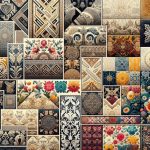Discover the fascinating journey of fabric innovations throughout history. From prehistoric techniques to cutting-edge contemporary technologies, this article takes you on a captivating tour of the world of textiles.
You’ll explore the ancient Egyptian advancements, Greek and Roman contributions, and medieval European innovations. Witness the transformative impact of the Renaissance and Baroque eras, as well as the Industrial Revolution’s groundbreaking techniques.
Join us as we unravel the rich tapestry of fabric evolution in this historical perspective.
Table of Contents
Prehistoric Fabric Techniques
Prehistoric humans used basic weaving techniques to create fabric for their clothing and shelters. These early weaving techniques were simple and involved interlacing plant fibers to form a sturdy and durable fabric. Prehistoric weavers would gather materials such as grasses, leaves, and bark from their surroundings, and then use their hands or primitive tools to weave these fibers together. This process required skill and patience, as each strand had to be carefully aligned and secured to create a cohesive fabric.
In addition to weaving, prehistoric humans also developed early dyeing methods to add color and patterns to their fabrics. They’d gather natural materials such as berries, roots, and insects, and then extract pigments from these sources. These pigments were then applied to the fabric, either by dipping, rubbing, or painting, to create vibrant and decorative designs. Although the range of colors available was limited, early dyers were able to create a variety of shades by experimenting with different materials and techniques.
Ancient Egyptian Textile Innovations
What textile innovations did the ancient Egyptians introduce?
The ancient Egyptians were pioneers in various aspects of textile production, including advancements in loom technology and dyeing techniques. They used horizontal looms, which allowed for the creation of wider and more intricate fabrics. This innovation enabled them to produce larger pieces of fabric, such as those used for clothing and furnishings.
Additionally, the Egyptians developed advanced dyeing techniques, using natural materials to create a wide range of vibrant colors. They used a variety of plant-based dyes, such as indigo and madder, as well as minerals and insects to achieve different hues.
The Egyptians were also skilled in the art of resist dyeing, where specific areas of the fabric were treated to create patterns or designs. This technique, known as tie-dyeing, allowed them to create intricate and visually appealing textiles.
Advancements in Greek and Roman Fabrics
The ancient Egyptians paved the way for advancements in fabric production, and this continued into the Greek and Roman civilizations. Greek and Roman weaving techniques built upon the knowledge of their predecessors, resulting in even more intricate and refined fabrics. Ancient Greek and Roman textile patterns were highly sought after for their sophistication and beauty. Here are some key advancements in Greek and Roman fabrics:
-
Brocade weaving: Greeks and Romans mastered the art of brocade weaving, creating elaborate patterns with raised designs. This technique involved weaving different colored threads together to form intricate motifs, adding depth and texture to the fabric.
-
Tapestry weaving: Greek and Roman weavers excelled in tapestry weaving, creating large-scale designs depicting scenes from mythology, history, and nature. These tapestries were highly valued and often used to adorn the walls of palaces and temples.
-
Dyeing techniques: Greeks and Romans developed advanced dyeing techniques, allowing for a wide range of vibrant colors. They used natural dyes derived from plants, insects, and minerals to create rich and varied hues.
-
Patterned borders: Greek and Roman fabrics often featured patterned borders, which were skillfully woven into the fabric using specialized looms. These borders added a decorative element and served as a distinguishing feature of Greek and Roman textiles.
-
Mosaic textiles: Inspired by the popular art of mosaic, Greek and Roman weavers incorporated geometric patterns and intricate designs into their fabrics. These mosaic textiles showcased the technical skill and artistic creativity of the weavers.
Through their ingenuity and expertise, the Greeks and Romans pushed the boundaries of fabric production, creating textiles that weren’t only functional but also celebrated for their beauty and craftsmanship.
Medieval European Textile Innovations
During this time, you’d witness significant advancements in medieval European textile production. Medieval weaving techniques were characterized by their complexity and attention to detail. Weavers used various types of looms to create intricate patterns and designs in their fabrics. One notable innovation was the introduction of the drawloom, which allowed for the creation of more intricate and detailed patterns. This technique revolutionized the textile industry, as it allowed weavers to produce fabrics with intricate designs more efficiently.
In addition to advancements in weaving techniques, medieval Europeans also developed innovative dyeing methods. Natural dyes were commonly used during this period, with plants, minerals, and even insects being used to create a wide range of colors. The process of dyeing involved boiling the fabric with the chosen dye material, which would then be absorbed by the fibers, resulting in vibrant and long-lasting colors.
These advancements in medieval European textile production had a significant impact on the economy and culture of the time. The availability of high-quality fabrics and vibrant colors allowed for the creation of elaborate and luxurious garments. The textile industry became a major source of income for many communities, leading to the growth of trade and commerce. Furthermore, the use of intricate weaving techniques and vibrant dyes in textiles became a symbol of wealth and social status.
Renaissance and Baroque Fabric Techniques
In the Renaissance and Baroque periods, you’d witness the refinement and expansion of fabric techniques. The artisans of this era were known for their intricate embroidery techniques, transforming plain fabrics into works of art. They’d skillfully stitch elaborate patterns and motifs onto garments, using techniques such as satin stitch, chain stitch, and couching. These embroidery techniques added a touch of luxury and elegance to the fabric, making it highly sought after by the elite.
Another notable innovation during this time was the production of velvet. Velvet, with its soft and luxurious texture, became a symbol of wealth and status. Artisans perfected the art of weaving velvet, creating a fabric that was both visually and tactically pleasing. The intricate weaving process involved the use of specialized looms and techniques, resulting in a fabric that had a dense pile and a rich, lustrous appearance.
In addition to embroidery and velvet production, other fabric techniques flourished during the Renaissance and Baroque periods. These included:
- Brocade weaving, which involved weaving intricate patterns with metallic threads to create luxurious and opulent fabrics.
- Lace making, where delicate and intricate patterns were created by hand or using specialized machines.
- Appliqué, which involved attaching decorative fabric pieces onto a base fabric, creating a three-dimensional effect.
- Block printing, a technique where intricate designs were carved onto wooden blocks and then stamped onto the fabric, creating repetitive patterns.
These fabric techniques revolutionized the textile industry during the Renaissance and Baroque periods, leaving a lasting impact on fashion and design.
Industrial Revolution and Modern Textile Innovations
As you delve into the Industrial Revolution and modern textile innovations, you’ll discover the profound advancements that revolutionized fabric production and transformed the fashion industry.
The impact of the industrial revolution on textile manufacturing can’t be overstated. During this period of rapid industrialization in the 18th and 19th centuries, traditional methods of fabric production gave way to mechanized processes that greatly increased efficiency and output. The invention of the spinning jenny, power loom, and cotton gin revolutionized the textile industry by automating various stages of production. These innovations allowed for the mass production of fabrics, making them more affordable and accessible to a wider range of people.
In addition, the development of synthetic fibers such as nylon and polyester in the 20th century further expanded the possibilities in modern textile manufacturing. These new materials offered enhanced durability, versatility, and performance, giving rise to innovative fabrics that could meet the demands of various industries, including sports, healthcare, and aerospace.
Today, modern textile manufacturing continues to push boundaries with advancements in sustainable materials, digital printing, and smart textiles, paving the way for a future where fabrics can be intelligent, responsive, and environmentally friendly.
Contemporary Fabric Technologies
Now let’s talk about the exciting advancements in contemporary fabric technologies.
Smart fabrics are revolutionizing the way we interact with clothing, offering features like temperature regulation and activity tracking.
Sustainable textile solutions are also gaining traction, with innovations in materials and production processes that minimize environmental impact.
Looking ahead, the future of fabric innovation holds endless possibilities, from self-cleaning fabrics to fabrics that can change color or shape.
Get ready to explore the cutting-edge world of fabrics!
Smart Fabrics Explained
Explore the world of smart fabrics and discover how they revolutionize contemporary fabric technologies. Smart fabrics are a remarkable innovation in the field of wearable technology. These fabrics are embedded with integrated sensors that can detect and respond to various stimuli.
Here are five key features of smart fabrics:
-
Sensing capabilities: Smart fabrics have the ability to sense and measure different parameters such as temperature, pressure, and even heart rate.
-
Connectivity: These fabrics can wirelessly connect to other devices, allowing for seamless data transfer and communication.
-
Adaptive properties: Smart fabrics can adjust their properties based on external factors, such as temperature or moisture, providing enhanced comfort and functionality.
-
Energy harvesting: Some smart fabrics can generate and store energy, enabling the possibility of self-powered wearable devices.
-
Applications: Smart fabrics have a wide range of applications, from healthcare and sports to fashion and entertainment.
With their integrated sensors and advanced capabilities, smart fabrics are transforming the way we interact with textiles, opening up new possibilities for innovation and functionality.
Sustainable Textile Solutions
Discover sustainable textile solutions that are revolutionizing contemporary fabric technologies. As the fashion industry becomes more aware of its environmental impact, eco-friendly alternatives are being developed to promote a circular economy. These innovative solutions aim to reduce waste, conserve resources, and minimize pollution throughout the textile production process. Take a look at the table below for some examples of sustainable textile solutions:
| Sustainable Textile Solutions |
|---|
| Recycled polyester |
| Organic cotton |
| Hemp fabric |
| Bamboo fiber |
| Tencel |
Recycled polyester is made from plastic bottles, diverting them from landfills and reducing the need for virgin polyester production. Organic cotton is grown without harmful pesticides, minimizing soil and water pollution. Hemp fabric is a durable and biodegradable alternative to synthetic fibers. Bamboo fiber is known for its softness and antimicrobial properties, while Tencel is a sustainable wood-based fiber made from eucalyptus trees. These eco-friendly alternatives are transforming the fashion industry by providing sustainable choices for consumers and promoting a more environmentally responsible approach to fabric production.
Future of Fabric Innovation
Look ahead to the future of fabric innovation and discover the exciting advancements in contemporary fabric technologies. The world of fabric is constantly evolving, and new technologies are revolutionizing the way we think about textiles. Here are some of the latest developments:
-
3D printed fabrics: Imagine being able to create complex, customized fabric structures using a 3D printer. This technology is already being explored and holds great potential for creating unique and functional textiles.
-
Biofabrication advancements: Scientists are making breakthroughs in the field of biofabrication, where living organisms are used to produce textiles. By harnessing the power of biology, we can create fabrics that are sustainable, durable, and even capable of self-repair.
-
Smart fabrics: With advancements in materials science and electronics, fabrics can now be embedded with sensors, microchips, and other electronic components. These smart fabrics have the ability to monitor vital signs, regulate body temperature, and even communicate with other devices.
-
Sustainable dyeing processes: Traditional fabric dyeing methods can be harmful to the environment due to the use of chemicals and water. However, innovative dyeing techniques are being developed that minimize waste and reduce the environmental impact.
-
Performance-enhancing fabrics: From moisture-wicking fabrics to temperature-regulating materials, innovations in fabric technology are improving the performance and functionality of textiles. These fabrics are designed to enhance comfort, durability, and overall performance in various applications.
The future of fabric innovation is bright, and these advancements are just the beginning. As technology continues to advance, we can expect even more exciting developments in the world of textiles.
Frequently Asked Questions
How Were Fabrics Made Before Prehistoric Times?
Before prehistoric times, fabric production techniques were rudimentary. Ancient fabric weaving involved using natural materials like animal skins and plant fibers. The process was labor-intensive and required manual labor to create textiles for clothing and shelter.
What Were the Primary Uses of Fabric in Ancient Egyptian Society?
In ancient Egyptian society, fabric was used for a variety of purposes. People used it for clothing, as well as for household items like bedding and curtains. Fabric production in ancient times involved weaving and dyeing techniques.
How Did Greek and Roman Advancements in Fabric Impact Their Respective Civilizations?
Greek and Roman fabric advancements had a significant impact on their respective civilizations. Improvements in clothing, trade, and social status resulted from these innovations, shaping the economic and social landscape.
What Were the Major Textile Innovations During the Medieval European Period?
During the medieval European period, you’ll learn about major textile innovations. Spinning techniques and dyeing processes were crucial advancements. These innovations revolutionized the way fabrics were created and colored, impacting society in numerous ways.
How Did Fabric Techniques Evolve During the Renaissance and Baroque Periods?
During the Renaissance and Baroque periods, fabric techniques evolved significantly. Innovations like brocade and damask were introduced, bringing intricate patterns and textures to clothing. These advancements had a profound impact on fashion and artistic expression.
- How Does Ring Spun Cotton Affect Garment Fit and Shape Retention? - August 13, 2024
- What Are the Challenges in Producing Ring Spun Cotton? - August 13, 2024
- Is Ring Spun Cotton Suitable for Plus-Size Clothing? - August 13, 2024




